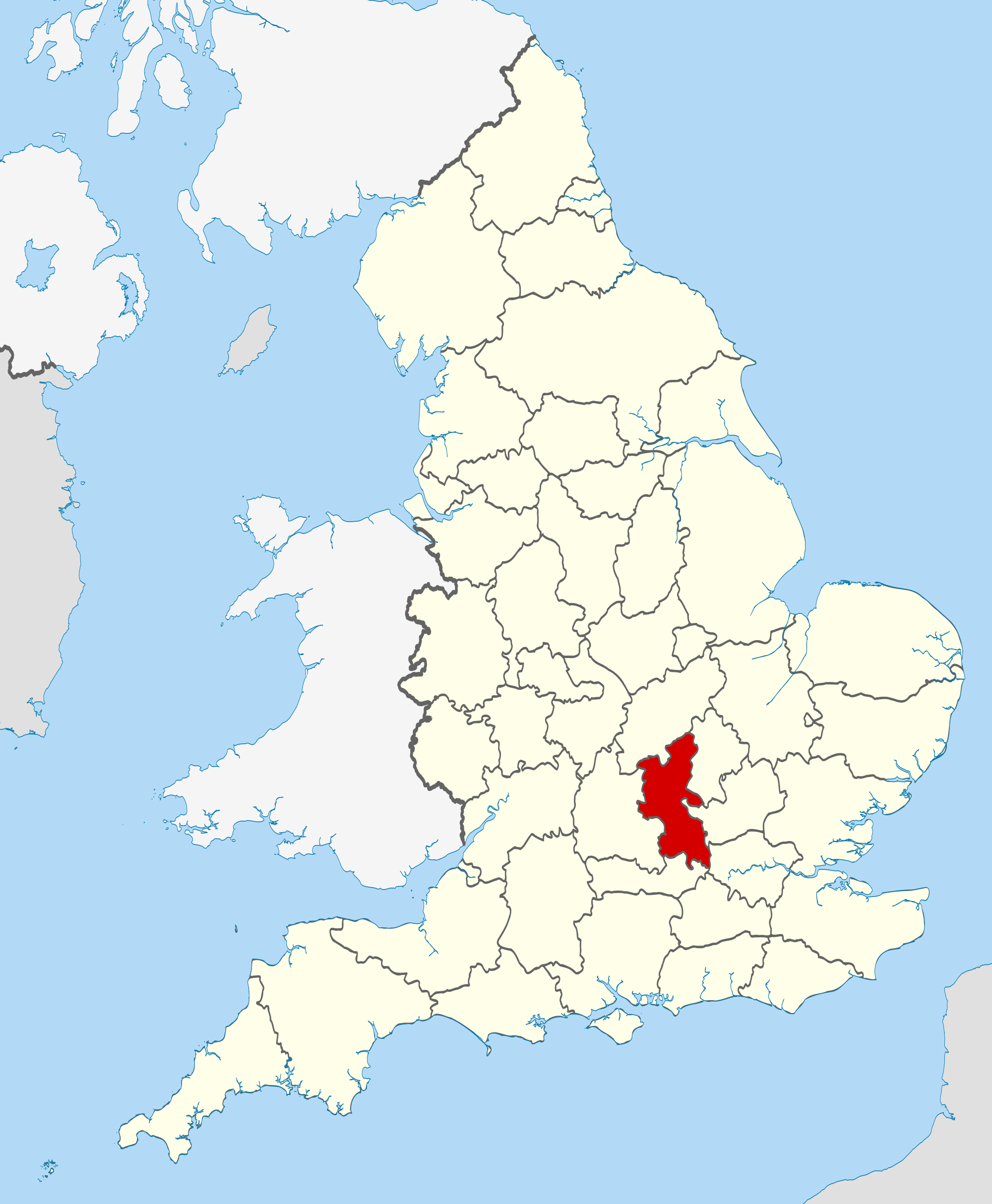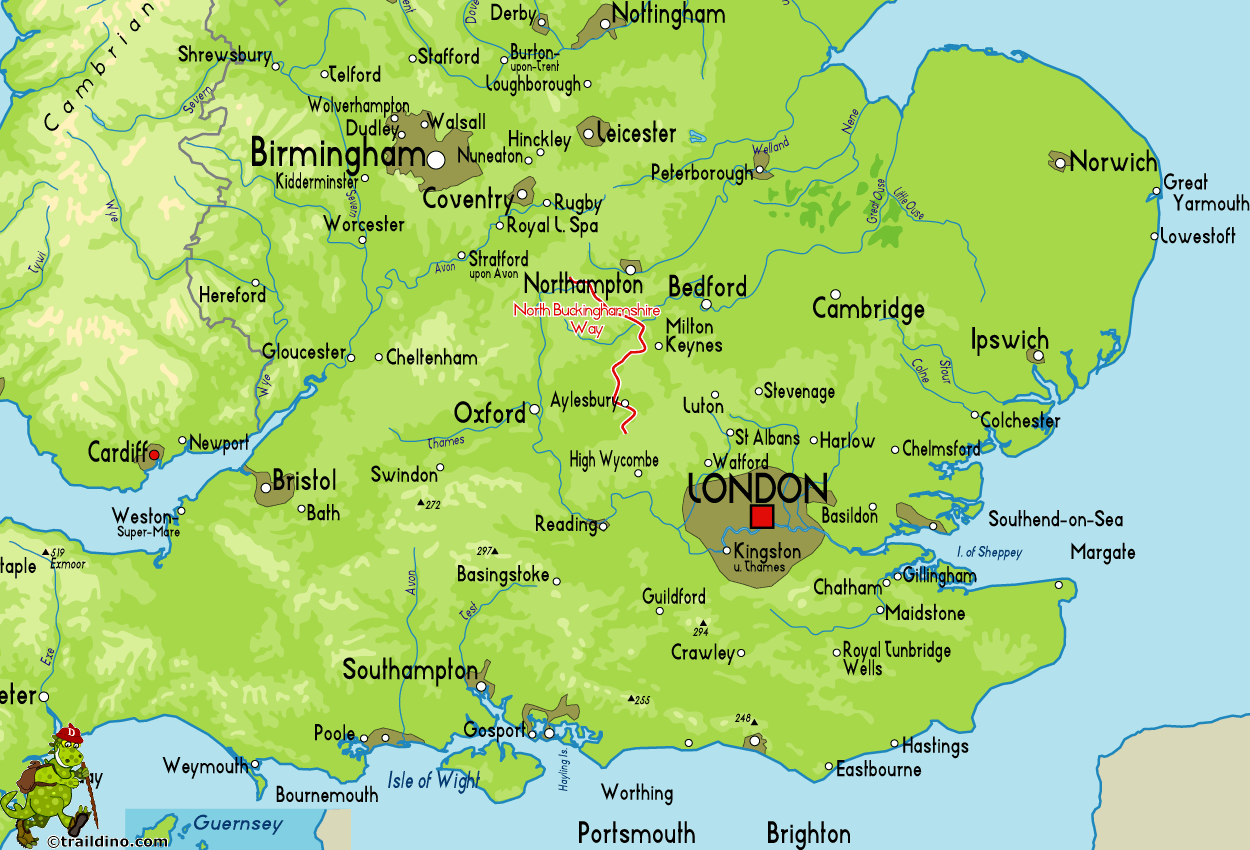Buckinghamshire
Buckinghamshire [ bʌkɪŋəmʃə ] (abbreviated Bucks ) is a named after the university town of Buckingham County in central southern England. Main town is Aylesbury, about 60 km north-west of London.
Buckinghamshire is divided into four districts: Aylesbury Vale, Chiltern, South Bucks and Wycombe. Previously also Milton Keynes belonged to the county, since 1997, this city together with the Borough of Milton Keynes an independent urban district ( Unitary Authority).
The traditional county bordering on Oxfordshire, Northamptonshire, Bedfordshire, Hertfordshire, Berkshire and Greater London. In the course of municipal reform of 1974 Slough and Eton came to Berkshire.
Buckinghamshire is dominated by agriculture; an industry focus in furniture production, and pharmaceutical products.
History
The name Buckinghamshire comes from the Anglo-Saxon and means " The district ( scire ) of Bucca 's home". Bucca 's home refers to Buckingham in the north of the county, which is named after the name of an Anglo-Saxon country gentleman. The county is named for the 12th century, Buckinghamshire, before that she was a part of the Kingdom of Mercia ( 585-919 ).
Some of the settlements in Buckinghamshire date from well before the Anglo-Saxons. Aylesbury about already exists since at least 1500 BC Some places still carry their originating from the British language names ( Penn, Wendover ) or have one made of a mixture of British incurred with the Anglo-Saxon language name ( Brill, Chetwode, Great Brickhill ). Everywhere traces can pre-Roman cultures.
The Roman influence in Buckinghamshire becomes particularly noticeable in the Roman roads which traverse the county. Watling Street and Akeman Street run east to west across Buckinghamshire and were important trade routes that linked London with other parts of the Roman Empire in Britain. The Icknield Way along the Chiltern Hills was used by the Romans as a line of defense; probably is the development of a much older road.
The Angles and Saxons are that ethnic groups who probably had the greatest impact on Buckinghamshire. They gave the county and many of the inherent within these places not only its name; the current size is also largely due to the Anglo-Saxon period. One of the great battles, which is mentioned in the Anglo-Saxon Chronicle, was beaten in Chearsley between Cerdic of Wessex and the British. Three of the saints that time were born in Quarrendon. In the late phase of the Anglo-Saxon period a royal palace in Brill was built. The great prosperity of the county was worth a mention in the Domesday Book.
The House of Plantagenet took advantage of the wealth of the country also. William the Conqueror annexed the most basic rule for himself and his family. The half-brother of William, Odo of Bayeux, became the largest landowner. Many old hunting grounds became the property of the king. Among the ancient traditions of Buckinghamshire breeding swans for the king, this is reflected in the coat of arms of the county ( see below).
For further annexations in favor of the crown, it was in connection with the dissolution of the monasteries ( 1536), as almost a third of the county personal property of King Henry VIII. Henry VIII was also the place Aylesbury Buckingham made the capital of the county to improve its relations with Thomas Boleyn and to be able to marry his daughter Anne.
In the English Civil War (1642-1649) Buckinghamshire was set mainly parliament. The hero of the Parlemtentsanhänger, John Hampden, came from Buckinghamshire and helped in the battle of 1642 to defend Aylesbury. Some places in the west of the county (eg, Brill and Boarstall ) were due to their proximity to the same parliamentary Aylesbury and Royalist Oxford in a permanent conflict. Many places disappeared as a result of this conflict from the map, but were rebuilt.
The Industrial Revolution and the building of the railway changed the landscape in different parts of the county. Wolverton in the north (now part of Milton Keynes ) became the national center of the carriage assembly; Furniture and paper industries settled in the south. In the center of the county lace - farms that grew quickly and provided work for the women and children of poor families originated. Buckingham has up to now good rail links to London, Birmingham and Manchester; the manufacture of furniture is still one of the main industries in the south of the county.
In the early Victorian era was rife a severe cholera epidemic; agriculture suffered significant crop losses. At this time, left many residents Buckinghamshire and settled in the surrounding towns. Landowners to use the opportunity to acquire the abandoned land cheap. This won the Rothschilds, one of the most influential families in the country, considerable importance in Buckinghamshire.
In the 20th century came to the north and south of the county to urbanization, arose as a consequence of planned cities such as Milton Keynes and Slough; both are unitary authorities since 1997.
The coat of arms of Buckinghamshire
The coat of arms of Buckinghamshire shows a white swan in chains. This goes back to the Anglo-Saxon period, were grown in the swans in Buckinghamshire for the king. The swan is in chains to show that he is the king belonging - an old law that is still valid today for the wild swans in the UK. The coat of arms was first, 1st Duke of Buckingham led by Humphrey Stafford at the Battle of Agincourt.
About the swan is a gold band, in the middle of the Whiteleaf Cross is depicted. There is a book that represents the forest of Chiltern, which once covered almost half the county, above the shield. On the right side is a stag, on the left a swan.
The Latin inscription reads: Vestigia Nulla retrorsum ( No traces lead back ).
Larger towns in Buckinghamshire
- Amersham
- Aylesbury
- Beaconsfield
- Buckingham
- Chesham
- Farnham Royal
- Great Missenden
- High Wycombe
- Marlow
- Princes Risborough
- Wendover
- Winslow
No longer belong to the county as a result of several municipal reforms:
- Bletchley
- Eton
- Fenny Stratford
- Milton Keynes
- Newport Pagnell
- Olney
- Slough
- Stony Stratford
- Wolverton
Attractions
- All Saints Church ( Wing ), Anglo-Saxon Church
- Ascott
- Ashridge Estate
- Bletchley Park
- Boarstall Tower
- Bradenham Village
- Buckingham Chantry Chapel
- Buckinghamshire Railway Centre in Quainton
- Chequers Court
- Claydon House
- Cliveden
- Dorneywood
- Eton College
- Halton Hall
- Hartwell House
- Hughenden Manor
- King's Head Inn, Aylesbury
- Long Crendon Courthouse
- Mentmore Towers
- Pitstone Windmill
- Princes Risborough Manor House
- Stowe Park
- Waddesdon Manor
- West Wycombe Caves
- West Wycombe Park
- West Wycombe Village
- Whiteleaf Cross
- Winslow Hall
- Wycombe Abbey
Sh. also List of Grade I historic buildings in Buckinghamshire










